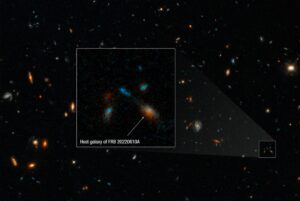Hubble Space Telescope reveals curious birthplace of record-breaking blast

A Hubble Space Telescope image of the host galaxy of an exceptionally powerful fast radio burst, FRB 20220610A. Credit: NASA, ESA, STScI, Alexa Gordon (Northwestern)
In summer 2022, astronomers detected the most powerful fast radio burst (FRB) ever observed. And coming from a location that dates halfway back to the Big Bang, it also was the farthest known FRB spotted to date.
Now, astronomers led by Northwestern University have pinpointed the extraordinary object’s birthplace — and it’s rather curious, indeed.
Using images from NASA’s Hubble Space Telescope, the researchers traced the FRB back to not one galaxy but a group of at least seven galaxies. The galaxies in the collection appear to be interacting with one another — perhaps even on the path to a potential merger. Such groups of galaxies are rare and possibly led to conditions that triggered the FRB.
The unexpected finding might challenge scientific models of how FRBs are produced and what produces them.
“Without the Hubble’s imaging, it would still remain a mystery as to whether this FRB originated from one monolithic galaxy or from some type of interacting system,” said Northwestern’s Alexa Gordon, who led the study. “It’s these types of environments — these weird ones — that drive us toward a better understanding of the mystery of FRBs.”
Gordon presented this research during the 243rd meeting of the American Astronomical Society in New Orleans, Louisiana. “Revealing the Environment of the Most Distant Fast Radio Burst with the Hubble Space Telescope” took place at 2:15 p.m. CST on Tuesday (Jan. 9) as a part of a session on “High-Energy Phenomena and Their Origins.”
Gordon is a graduate student in astronomy at Northwestern’s Weinberg College of Arts and Sciences, where she is advised by study co-author Wen-fai Fong, an associate professor of physics and astronomy. Fong and Gordon also are members of the Center for Interdisciplinary Exploration and Research in Astrophysics (CIERA).
Continue to the full Northwestern news Article.

